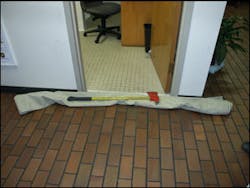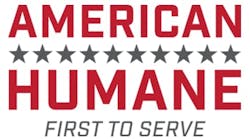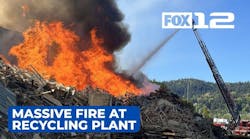Here's the scenario: You are dispatched to a reported structure fire. You are the officer on the fourth-due engine. The first-on engine reports a two-story, wood-frame, residential structure with fire showing from a second floor window. They pull a 1 3/4-inch line. The first-on truck arrives and forces entry for the engine and starts a primary search. The second-on engine is ordered to come in and give their tank water to the first engine. The third-on engine is assigned to come in and assist with checking for extension. Your engine company arrives on scene and is assigned as Rapid Intervention Team (RIT). The second-due truck is staged and eventually assigned to perform salvage operations.
The fire is placed under control and was confined to the one bedroom upstairs. There is moderate smoke damage throughout the second floor. The first floor is relatively free of smoke. Due to the extinguishment and overhaul efforts in the room of origin, there is a constant flow of water through the ceiling fixtures onto a hardwood floor in the downstairs living area. The fire has been placed under control and your company that has been standing by as RIT (with all of the proper tools, of course) is reassigned to assist with salvage by command.
Knowing that salvage is typically assigned to truck companies, are you and your crew going to be able to perform this task proficiently? When is the last time that you were assigned to perform salvage? Is salvage a subject that you cover at all with any of your in-house training?
The above scenario happened to me about seven years ago. I was the rank of Engineer and was acting up in the role of the officer of the engine company that I was assigned to. The last training I had with salvage was during rookie school. We were given the assignment to assist with the protecting of downstairs furnishings from water damage. We were fortunate to have performed this task with some level of competency. Training on this subject may seem either mundane or simple, and it is; but it is none the less important.
Including this subject into a training regiment would require most of us to do a little homework. As with any help that is given to you, you should always check the other person's work to make sure it suits your company's specific needs.
For this article we are not going to go through all of the different tarp throws and the different ways to fold a tarp. The Company Level Training articles are only concerned about the hands-on application of the different skills that you could be required to use on the fireground. We are going to talk about the different uses of a tarp to prevent damage from smoke and water.
The easiest method for preventing damage is by grouping furniture in a room and covering that grouping with a tarp. If possible, place the tallest pieces of furniture in the center of the grouping. This will help the water to flow down and away from the grouping when covered by a tarp. Be careful not to cause any further damage, if possible, to the furniture in the process of moving it.
Some books show pouring some type of absorbent material around the grouped furniture to prevent water from damaging the bottom of the furniture. I have never personally seen this done. I would think that if you were going to use absorbent that it would be better to lay the bottom part your tarp out flat from the furniture and then spread the absorbent on the top side of this flat edge of the tarp. This would prevent water from seeping underneath your tarp and keep the absorbent off of the floor itself.
Forming a dike is another task that is often performed with tarps. This can be done by rolling the tarp up and placing it in front of a doorway or opening to prevent water from going into another room. The tarp can be weighted down with hand tools, absorbent or anything else with some weight to it from the residence.
My engine company had to do this at a fire at a YMCA where the sprinkler system activated. The floors were some type of cheap tile. Therefore, water flowed over the top of them with ease. We were trying to keep the water from the different rooms that had no been affected by the fire. This improvised dike made using a tarp worked well enough to keep a majority of the water out of the unaffected rooms.
The last use of tarps that we will discuss is a water chute. In 13 years with my department, I have had to use this technique once. By performing this task with a relative amount of competence, we were able to save quite a bit of damage to a very nice wood floor. Water was coming out of a light fixture from the fire extinguishment efforts directly above the living room. The light fixture was located within 10 feet from a window.
We were able to take the screen off of the window and open the window. We took a tarp off of a truck company on scene along with two 12-foot pike poles. We laid the tarp out to where it was folded in half. We laid the pike poles on either side of the tarp and rolled each pike pole up five or six times each. This formed a chute that was about a foot and a half wide. We moved a tall piece of furniture close to the leaking light fixture. We were able to take the hooks of the pike poles and hook them onto the top edge of this piece of furniture. We then took the bottom part of the chute and placed it out the window. The water was now landing on the slide part of the chute and flowing out of the window. Not too bad for a bunch of water wagon weenies - that's what Lt. Mike Wilbur of FDNY likes to call us engine guys.
One last option for salvage operations is the use of clear plastic rolls. Visqueen seems to be a very popular brand. The advantage of using this type of material is that it is cheap and can be cut to fit your company's particular need for each individual fire scene. Another advantage is that once the plastic is in place whether to cover furniture or to cover a ventilation hole that has been cut in a roof; it can be left for the owner/occupant to use as long as they need. It is not necessary to retrieve the plastic due to the inexpensive nature of the plastic.
As boring as the subject of salvage is, there is not a more important task short of fire extinguishment and rescue, which can be performed. The skill in which you perform this mundane task will have a direct impact on the quality of life of our fire victims. Hope is given by being able to save just a few items from a residence. It could be all of the household furniture, the family Bible or family pictures that can never be replaced. Good salvage work will enhance the image of the fire service more that just about any other task. It should be taken seriously and trained on a few times during the year.
I want to thank the crew of Quint 24 "A" shift, in Fort Worth, for their help with the photo's for this article and also for the advice on salvage operations.
Please send any ideas for future training drills, or suggested improvements and variations on this drill, to my e-mail at [email protected]. You and your department will receive credit for any ideas used in future articles.
Related Links:
- Company Level Training - An Introduction & links to all Company Level Training articles
- Webcast:Company Level Training by Larry Manasco
Larry Manasco will present: Company Level Training: Designing a Training Program at your Station to Fit Your Specific Needs during Firehouse World, being held in San Diego Feb. 3-7, 2008.
Larry Manasco has been with the Fort Worth, TX, Fire Department for 13 years and has served as a lieutenant for the past four years. He holds the classification of Fire Officer I and Hazardous Materials Technician. He currently works in one of the busiest engine companies in Fort Worth. He has worked for Firehouse World in San Diego where he was an assistant instructor for FDNY Battalion Chief Salka's "Get Out Alive" H.O.T. class. Click here to view Larry's recent webcast, "Company Level Training." You can contact Larry by e-mail at [email protected].






